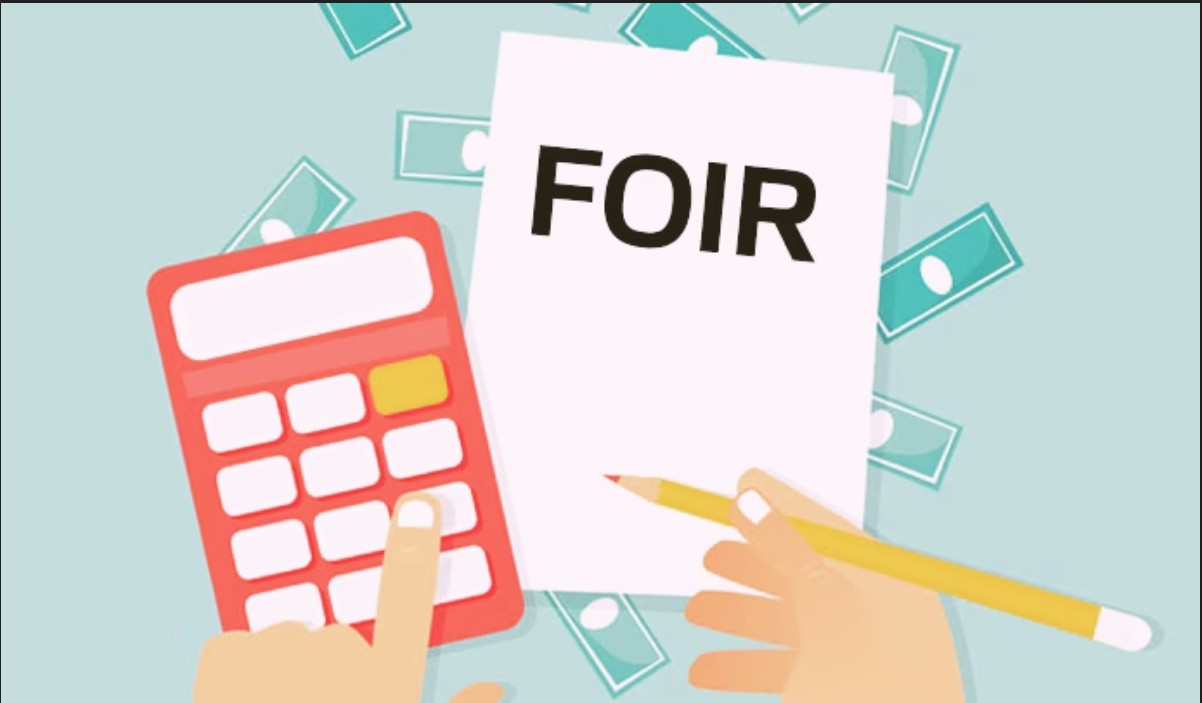Your Fixed Obligation to Income Ratio (FOIR) is one of the most critical factors lenders examine when you apply for a loan. It helps banks and financial institutes measure a potential borrower’s financial capacity by comparing monthly income to other existing financial commitments.
Lenders use FOIR to evaluate borrowers’ capacity to take on additional loans or non-credit facilities without being financially strained. A lower FOIR increases the chance of loan approval as it shows a better balance between income and financial obligations. By learning to calculate FOIR, borrowers will improve their chances of securing additional loans and better terms.
What is FOIR?
The Fixed Obligation to Income Ratio (FOIR) is a financial metric used by banks and financial institutions to analyse a borrower’s ability to repay an amount. It reveals what percentage of a borrower’s income goes toward fixed obligations such as existing loan EMIs, credit card dues, and other liabilities.
The lender uses the FOIR calculation to evaluate whether a person is in a position to take on additional debt without creating a financial burden for themselves. The lower FIOR shows that the borrower has sufficient disposable income after servicing existing debts, which increases their chance of loan application approval. However, when the FIOR is high, it indicates that the borrower is under a heavy financial burden, which reduces the chance of loan approval.
Understanding FOIR in banking is important for the borrower to enhance loan eligibility and negotiate better loan terms.
How is FOIR Calculated?
The Fixed Obligation to Income Ratio (FOIR) is used by lenders to determine the debt burden of the borrower as compared to their income. The value of FOIR can be calculated by using the following formula:
FOIR= (Total fixe obligation)*100/(Total Monthly income)
What Are Fixed Obligations?
Fixed obligations comprise all financial liabilities that must be paid by a borrower in a month, such as:
- Existing loan EMIs (personal loan, home loan, car loan, etc.)
- Credit card dues (minimum monthly payments)
- Other fixed liabilities (consumer durable loans, ongoing EMIs for gadgets, etc.)
However, living expenditures such as rent and utility bills are not considered fixed obligations under FOIR calculations.
Example Calculation
Assuming that:
- Net Monthly Income = ₹50,000
- Existing Loan EMI = ₹10,000
- Credit Card Minimum Payment = ₹5,000
FOIR= (10000+5000)*100/50000
FOIR=(15000)*100/50000= 30%
In this example, the borrower’s FOIR is 30%, which means 30% of their monthly income is already bound to fixed obligations. If the lender’s FOIR limit is set at 40%, then in this particular case, the borrower may qualify for a loan. However, if the FOIR value of the borrower is more than the lender’s set limit, then the lender is required to reduce their liabilities or increase their income to enhance their chance of qualification.
Ideal FOIR for Loan Approval
Lenders calculate FOIR for loan approval to get an idea of how the applicant can manage the additional debt without being distressed. It is one of the major factors banks consider when a person applies for a loan.
Recommended FOIR for Different Loans
|
Loan Type |
Ideal FOIR Range |
Approval Criteria |
| Personal Loans | 40-50% | FOIR plays a major role in personal loan approval factors as personal loans are unsecured. Lenders prefer the borrower with the FOIR below 50% to ensure the borrower’s repayment capacity. |
| Home Loans | 50-60% | The FOIR percentage for home loans is higher because they are secured. |
| Business Loans | Varies by lender | FOIR calculations for business loans are based on cash flows and financial stability. |
Lender-Specific FOIR Variations & Approval Criteria
- Government Banks & NBFCs
Provide flexibility of FOIR limit for salaried applicants who have stable income. It may approve a higher FOIR for the applicant who has multiple income sources and a strong credit history.
- Private Banks
Private banks have strict FOIR limits, generally below 50% for personal loans and 60% for home loans. Approves a higher FOIR limit for existing customers who have a good repayment record.
- FinTech Lenders & Digital Loan Providers
They use alternative models for credit assessment other than FOIR. Loans with high FOIR are approved based on spending patterns, bank transactions, and overall financial behavior.
How FOIR Affects Your Loan Eligibility
The Fixed Obligation to Income Ratio (FOIR) is one of the most important parameters assessed by lenders. This helps them analyze if the borrower can handle additional debt along with existing financial commitments. FOIR is said to have a direct bearing on whether a borrower’s loan will be approved or whether the lender will offer special terms.
High FOIR: Increased Rejection Risk
High FOIR means that a major percentage of the borrower’s current income is already committed to fixed obligations, such as EMIs and credit card payments. This is seen as a higher risk of default that makes lenders reluctant to provide any further loans. FOIR above 50-60% mans:
- Rejection of loan application or lower than anticipated loan amount approval
- Loans at higher interest rates to compensate for risk
- A requirement for additional income sources or offering collateral for secured loans
Low FOIR: Better Chances of Loan Approval
A low FOIR means that a borrower stands in a safer position, one with adequate disposable income left after servicing the existing debts. Thus, borrowers with an FOIR below 40-50% could get:
- High chance of approval
- Better loan terms and conditions, such as interest
- Higher loans based on recipient’s repayment capacity
How Lenders Assess Risk Based on FOIR
Alongside other factors like credit score, income stability, and type of employment, lenders also consider the FOIR of the person before approving the loan. A borrower having a moderate FOIR (40-50%) along with a stronger credit profile can get approval, which might not be the case with someone with a lower FOIR and abrupt change in income.
A clear understanding of FOIR helps the borrower in managing their funds wisely, seeing how FOIR affects their loan eligibility, hence increasing the chances of securing loans at favorable terms.
How to Improve Your FOIR for Loan Approval
A high Fixed Obligation to Income Ratio (FOIR) reduces the chances of approval because it shows heavy financial burdens. Here are ways to better your FOIR and increase eligibility:
1. Reduce Existing Debts and EMIs:
Paying off small loans or consolidating multiple debts with one low-interest loan will reduce monthly financial burdens. Decreasing the use of credit cards or refraining from availing of new loans until approval helps improve your FOIR.
2. Increase income sources:
The higher your net monthly income, the lower your FOIR percentage will be, thus improving your possibility for loan eligibility. You could consider freelance work, renting out property, or asking for a raise to increase your income to qualify for a loan.
3. Opt for Longer Tenure Loans:
If you extend your loan tenure, it will lead to lower EMI and better FOIR calculations. However, this increases the total interest cost; hence, choose this option carefully according to affordability.
4. Close Unused Credit Lines:
Even though some credit cards are lying unused, they also count for financial obligations. One should close those unnecessary lines of credit and ensure that the old loans are marked “closed” in the credit report so that it can create a much more impactful financial portfolio and help improve FOIR for loan approval.
By making these changes, you can bring your FOIR percentage closer to the lender’s eligibility range and improve your chances of approval.
FOIR vs. Other Loan Eligibility Factors
Apart from the Fixed Obligation to Income Ratio (FOIR), determining eligibility criteria for loans involves certain other financial variables. Here’s how FOIR compares to other key loan assessment factors:
1. FOIR vs. Debt-to-Income Ratio (DTI)
FOIR and DTI both measure the debt obligations of a borrower, but they differ in scope. FOIR considers fixed financial commitments like EMIs or credit card dues, while DTI factors in all expenses, including rentals and utility bills. In India, lenders majorly rely on FOIR, whereas DTI gains more acceptance in the international market.
2. FOIR vs. Credit Score
Credit score defines the past repayment history of a borrower and indicates their creditworthiness, while FOIR checks their present repayment capacity. A borrower with a much higher credit score may be denied a loan altogether on high FOIR percentages, as that implies having high financial obligations. Together, both factors influence loan approval and interest rates.
3. FOIR vs. Loan-to-Value Ratio (LTV)
Loan-to-Value Ratio refers to the secured loans types, like home loans, and it reflects the percentage of the total value of property a lender is willing to finance. Low values for both FOIR and LTV improve the chances of approval and let you get the loan on better terms.
The lender evaluates FOIR with these factors before approving a loan to determine an applicant’s overall creditworthiness and risk level. This balance ensures a better scope of approval on favourable terms.
Conclusion
The Fixed Obligation to Income Ratio (FOIR) is a very important factor in determining eligibility criteria for lending that help lenders ascertain the repayment capability of the borrower. A lower percentage of FOIR increases the chance of loan approval. A higher percentage of FOIR may cause rejection or tougher loan terms.
An ideal FOIR calculation would require discipline regarding basic finances, such as reducing existing debts, increasing income where possible, and managing credit wisely. A borrower who seeks to improve it for loan approval should perhaps be working on balancing their financial obligations to ensure better loan terms.
The borrowers who are insecure about their FOIR percentage should consult a financial advisor who can help them to improve their FOIR percentage and improve their overall financial health.
Also, read:
- How To Avail an Online Personal Loan
- Personal Loan for Women
- How to get an Instant Small Cash Loan on Aadhaar Card?
- How to Get an Instant Personal Loan Without Income Proof?
- Personal Loan Preclosure Procedure
This post is also available in: हिन्दी (Hindi)




